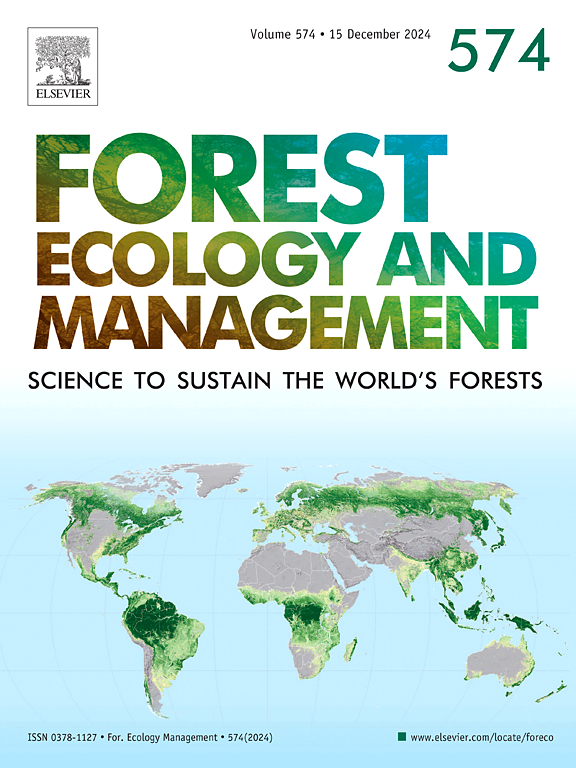膨润土作为不同水质条件下的基质调节剂--桉树幼苗试验
IF 3.7
2区 农林科学
Q1 FORESTRY
引用次数: 0
摘要
在培育优质秧苗的过程中,基质有很多功能,包括保持水分和为植物提供水分。膨润土就是一种可以用来保持水分的化合物。因此,研究的目的是评估在两种水质条件下,不同比例的膨润土作为基质成分对桉树幼苗培育的影响。研究在巴西库里提巴(Curitiba/PR)的林木育苗场进行。在处理过程中,膨润土基质调节剂在商品基质(含泥炭)中的使用比例不同,分别为 0%、5%、10%、15% 和 20%,分别命名为 S0、S5、S10、S15 和 S20。用这些膨润土比例培育出的幼苗的高度、茎径、干物质(芽、根和总量)以及两个参数:高度/茎径比(H/SD)和迪克森质量指数(DQI)进行了分析。基质分析结果与预期相反。虽然 5% 的膨润土能使幼苗生长良好,但高比例的膨润土并不能提高幼苗在低水位条件下的持水量,因此基质中膨润土提高持水量和减少灌溉的目的并不能完全达到。本文章由计算机程序翻译,如有差异,请以英文原文为准。
Bentonite as substrate conditioner under different water regimes – A Eucalyptus dunnii seedling assay
The substrate has a lot of functions in the process to develop a high-quality seedling, including the responsibility to hold water and to make the water available for the plants. A compound that can be used to hold water is bentonite. So, the research aimed to evaluate the effects of different proportions of bentonite as a substrate component under two water conditions in the production of Eucalyptus dunniii seedlings. The research was carried out in the forest seedlings nursery in Curitiba/PR - Brazil. For the treatments, bentonite substrate conditioner was used in different proportions, 0 %, 5 %, 10 %, 15 % and 20 %, in a commercial substrate (with sphagnum peat) here named as S0, S5, S10, S15 and S20 respectively, in two water regimes for the blocks. The seedlings produced with these bentonite proportions was analyzed by the height, stem diameter, dry matter (shoot, root and total), and two parameters: height/stem diameter ratio (H/SD) and Dickson Quality Index (DQI). The substrate analysis shown a contrary behavior of expected. The bentonite in the substrate for seedlings of E. dunnii did not increase water holding capacity in a linear form and the high proportion of bentonite did not improve seedling in the lower water regime, although the 5 % of bentonite gave a good results of seedlings growth, so the purpose of bentonite in the substrate to improve water holder capacity and minimize the irrigation would not be fully attended.
求助全文
通过发布文献求助,成功后即可免费获取论文全文。
去求助
来源期刊

Forest Ecology and Management
农林科学-林学
CiteScore
7.50
自引率
10.80%
发文量
665
审稿时长
39 days
期刊介绍:
Forest Ecology and Management publishes scientific articles linking forest ecology with forest management, focusing on the application of biological, ecological and social knowledge to the management and conservation of plantations and natural forests. The scope of the journal includes all forest ecosystems of the world.
A peer-review process ensures the quality and international interest of the manuscripts accepted for publication. The journal encourages communication between scientists in disparate fields who share a common interest in ecology and forest management, bridging the gap between research workers and forest managers.
We encourage submission of papers that will have the strongest interest and value to the Journal''s international readership. Some key features of papers with strong interest include:
1. Clear connections between the ecology and management of forests;
2. Novel ideas or approaches to important challenges in forest ecology and management;
3. Studies that address a population of interest beyond the scale of single research sites, Three key points in the design of forest experiments, Forest Ecology and Management 255 (2008) 2022-2023);
4. Review Articles on timely, important topics. Authors are welcome to contact one of the editors to discuss the suitability of a potential review manuscript.
The Journal encourages proposals for special issues examining important areas of forest ecology and management. Potential guest editors should contact any of the Editors to begin discussions about topics, potential papers, and other details.
 求助内容:
求助内容: 应助结果提醒方式:
应助结果提醒方式:


